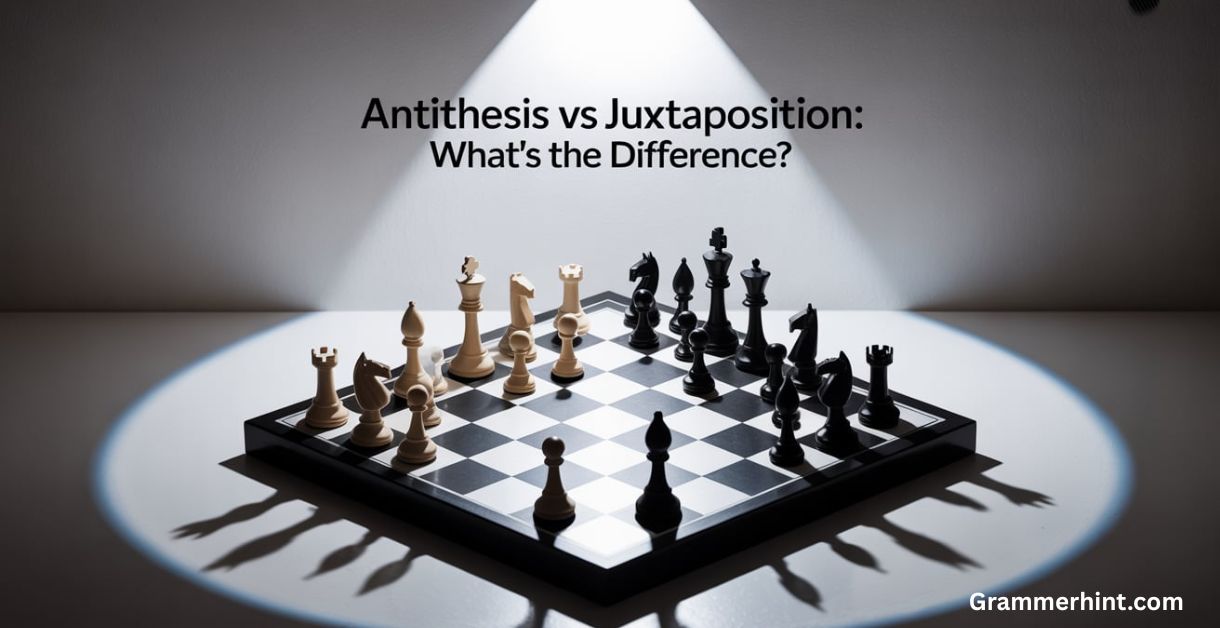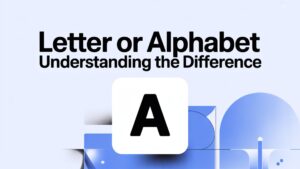When you dig into literary techniques, you’ll often encounter antithesis and juxtaposition. At first glance, they seem similar because both deal with contrast and placing things side by side.
But look a little closer, and you’ll find some key distinctions that impact everything from rhetorical impact to emotional evocation.
This article breaks down the difference between juxtaposition and antithesis clearly. You’ll find plenty of examples, origins from Ancient Greek rhetoric, and practical tips for spotting or using these powerful tools in your own writing.
What is Antithesis?
Antithesis comes from the Greek words anti (against) and thesis (position), meaning “opposite position.” It’s a rhetorical device that deliberately puts opposing ideas in close proximity to emphasize their contrast. This technique often appears in persuasive writing, speeches, and literary genres like poetry and drama to create strong thematic contrast.
By emphasizing the difference between antithesis and juxtaposition, antithesis uses antithetical phrases to heighten tension or drama, often through parallel structure.
Examples of Antithesis
Consider these classic antithetical phrases:
- “To err is human, to forgive divine”
- “United we stand, divided we fall”
- “Darkness cannot drive out darkness; only light can do that”
Each example places opposing ideas side by side, underscoring their tension and contrast with rhythmic balance.
Here’s a casual email scenario where antithesis works well:
Subject: Project Deadline: Urgent Attention Needed
Hi Lisa,
We must act swiftly but carefully. Rushing could cause mistakes, but delaying risks missing the client’s deadline. Let’s find the balance and push forward confidently.
Best,
Mark
Mark’s email uses antithesis to highlight opposing risks, emphasizing the need for balance and careful decision-making.
Origins of Antithesis
The roots of antithesis trace back to Ancient Greek rhetoric, where figures like Aristotle and Cicero formalized its use in classical rhetoric. This device became a paradigm for persuasive speech, with its influence stretching through Roman literature to modern writing.
What is Juxtaposition?
Juxtaposition refers to placing two or more elements side by side to create contrast or highlight disparities. Unlike antithesis, which emphasizes opposing ideas, juxtaposition can involve subtle or even neutral comparisons that provoke thought through visual storytelling, imagery, or thematic interplay.
In literature, you might find juxtaposition used to set contrasting settings, moods, or characters within a story. It relies heavily on figurative language and imagery and symbolism to deepen meaning.
Examples of Juxtaposition
Look at these literary contrasts:
- “The bustling city streets contrast sharply with the peaceful countryside.”
- “The delicate flower bloomed amidst the thorns.”
- “The old man’s wrinkled face told the story of a lifetime.”
In each case, the images are juxtaposed to enrich the narrative or evoke emotion by showing contrasting images or contrasting vocabulary.
Imagine a marketing email where juxtaposition adds punch:
Subject: Escape the Noise, Find Your Calm
Hi Amanda,
Between the nonstop chatter of the city and the quiet calm of our retreats, you’ll find the peace you deserve. Step away from the chaos and recharge with us.
Warm regards,
Serenity Spa Team
Here, the email juxtaposes hectic city life with peaceful retreats, using imagery to evoke emotions and attract the reader.
Origins of Juxtaposition
The term stems from Latin roots juxta (next to) and positio (position). Although it doesn’t trace to a single origin like antithesis, it became a key technique in literary contrast and visual storytelling, widely used in everything from poetry to painting.
Antithesis vs Juxtaposition: The Differences
At their core, the difference between antithesis and juxtaposition lies in intent and structure:
| Aspect | Antithesis | Juxtaposition |
|---|---|---|
| Definition | Direct opposition using contrasting ideas | Placing elements side by side for contrast or comparison |
| Focus | Emphasizes opposing ideas in balanced structure | Highlights disparities or relationships, often subtle or thematic |
| Form | Usually verbal or written phrases with parallelism | Can be visual, narrative, or textual |
| Examples | “Love is an ideal thing, marriage a real thing” | “The bustling city streets contrast sharply with the peaceful countryside” |
| Purpose | Provokes thought through clear contradiction | Evokes emotions or themes through comparison |
| Literary Device Type | Rhetorical device | Literary technique |
Understanding these nuances helps writers and readers appreciate how each tool shapes literary clarity, emotional depth in writing, and rhetorical effectiveness.
How To Use Antithesis and Juxtaposition In Sentences
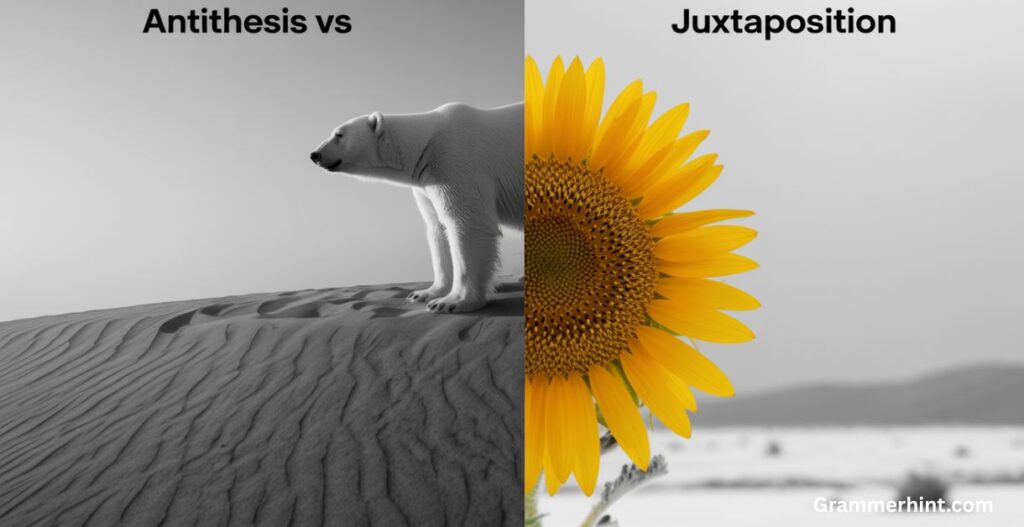
Antithesis
Try crafting sentences that put contrasting ideas in parallel structure. For example:
- “She is young but wise.”
- “We must learn to give and to take.”
Here, the balance adds rhythm and strengthens the literary contrast.
Juxtaposition
Place contrasting images or ideas side by side to highlight differences without explicitly opposing them:
- “The cold winter night was lit by the warm glow of the fireplace.”
- “His laughter echoed in the silence of the empty room.”
Combining Antithesis and Juxtaposition
You can also blend the two for richer expression. For example:
- “In the silence of the city, chaos finds its calm.”
Here, the sentence juxtaposes silence and chaos while containing antithetical concepts.
Examples Of Antithesis and Juxtaposition Used In
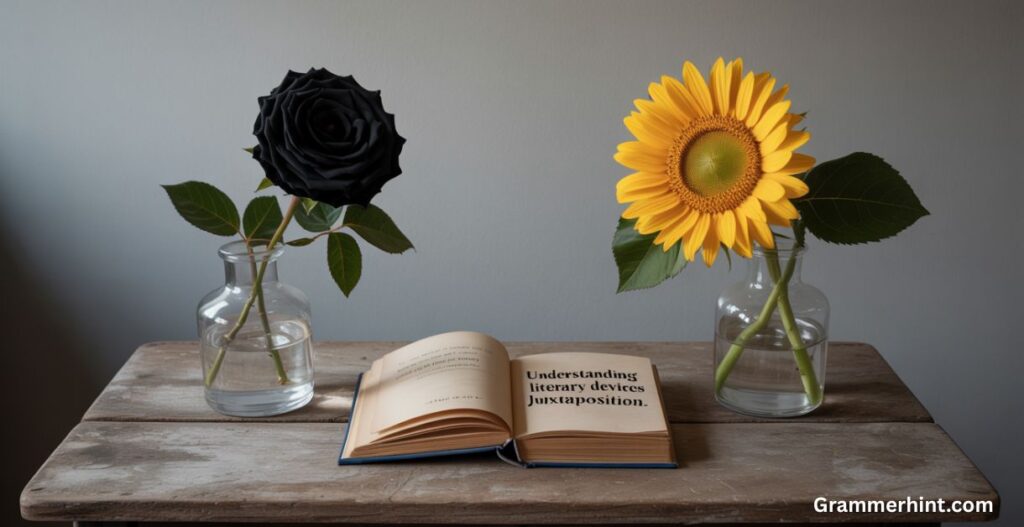
Antithesis Examples
- “The pen is mightier than the sword.”
- “To be or not to be.”
- “It was the best of times, it was the worst of times.”
Juxtaposition Examples
- “The delicate flower bloomed amidst the thorns.”
- “The old man’s wrinkled face told the story of a lifetime.”
- “The bustling city streets contrast sharply with the peaceful countryside.”
Combined Examples
- “Darkness cannot drive out darkness; only light can do that.”
- “Love is an ideal thing, marriage a real thing.”
Common Mistakes to Avoid when using Antithesis and Juxtaposition
- Overusing these devices can dilute their impact.
- Lack of clarity when contrasts are weak or mismatched.
- Pairing elements that don’t fit contextually, creating forced symmetry.
- Ignoring revision and refinement, which can lead to awkward phrasing or confusion.
Tips for Avoiding These Mistakes
- Always ensure contrasts make sense within the literary genres or writing style.
- Use revision and refinement to polish and enhance rhetorical impact.
- Avoid overusing; let these devices shine where they matter most.
- Balance figurative contrast with straightforward language to keep the message clear.
Where to Use Antithesis and Juxtaposition
Both techniques thrive in:
- Persuasive writing and speeches for rhetorical effectiveness.
- Poetry, prose, and drama for enriching themes and imagery.
- Marketing and casual communication to evoke emotion and paint vivid pictures.
- Formal reports when you want to highlight disparities clearly.
Where Not to Use Antithesis and Juxtaposition
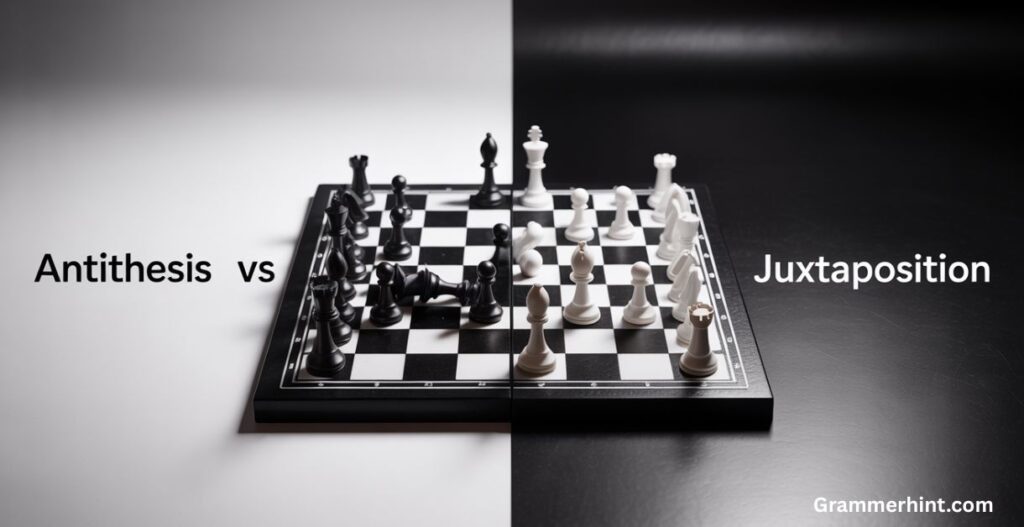
Avoid these devices in:
- Sensitive topics like trauma or grief, where heavy contrast might feel harsh.
- Technical writing, legal writing, or medical/scientific papers where clarity and precision matter most.
- Situations requiring historical or factual accounts without embellishment.
A Final Look at Antithesis vs Juxtaposition
Both antithesis and juxtaposition hold a special place in the toolbox of language devices. They enrich writing by emphasizing differences, creating contrast, and provoking thought. Understanding the subtle but significant difference between juxtaposition and antithesis allows you to use each with purpose and flair.
Remember: Antithesis often hits you with sharp, rhythmic opposing ideas. Juxtaposition invites you to pause, compare, and feel the space between images or concepts. Together, they offer a powerful way to enhance literary engagement and sharpen your writing techniques.
